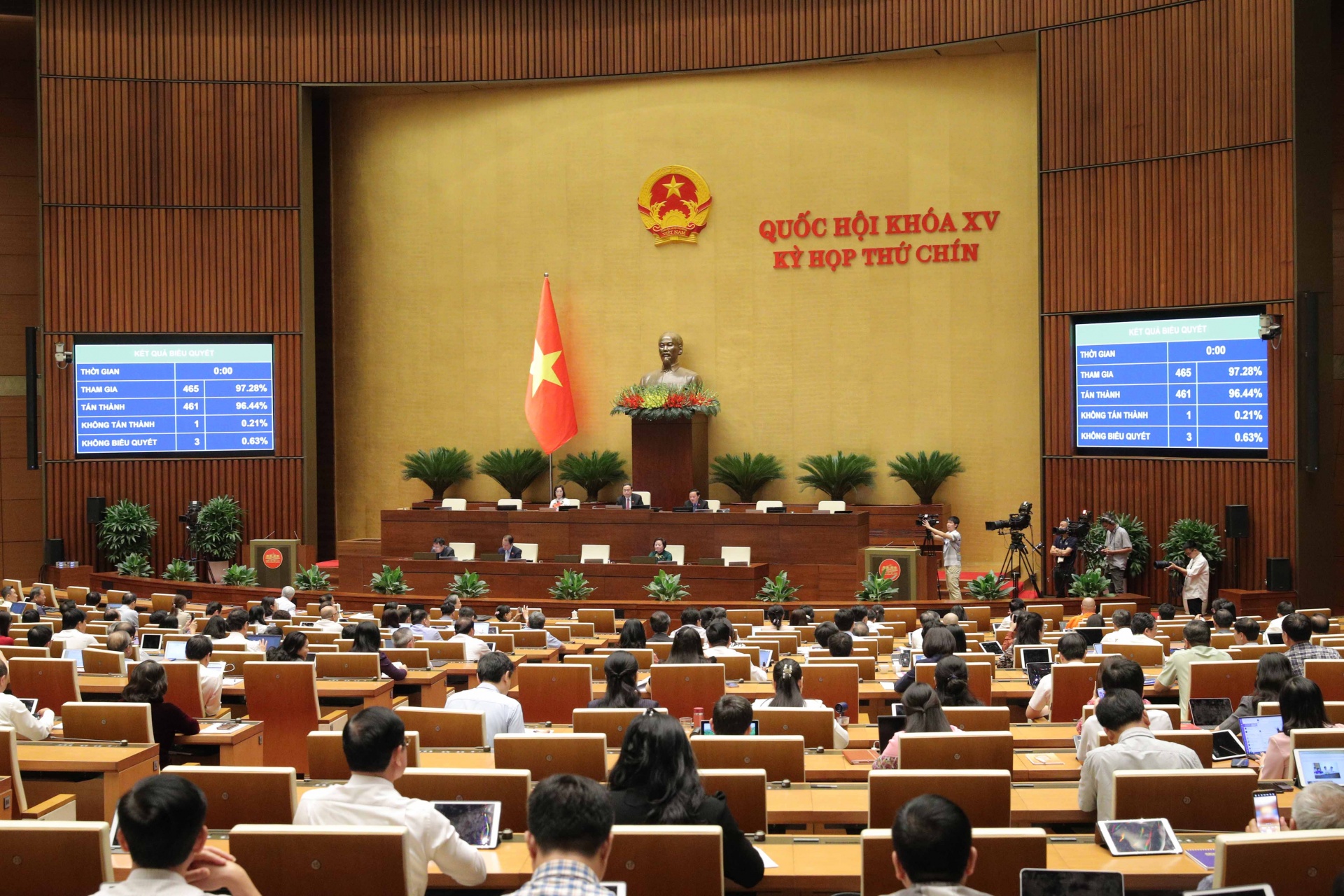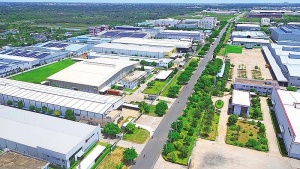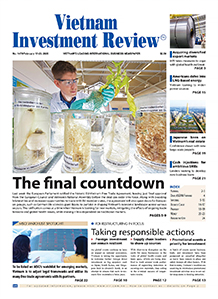Major administrative reform to boost growth and efficiency
With an overwhelming 96.4 per cent of delegates voting in favour, the NA approved the resolution on reorganising provincial-level administrative units on June 12.
This transformative decision is expected to unlock new avenues for national development and enhance the leadership role of key growth drivers.
 |
| The NA session on June 12 |
In light of the resolution, the number of provinces and centrally governed cities has been reduced to 34, comprising six centrally governed cities; Hanoi, Ho Chi Minh City, Haiphong, Hue, Danang, and Can Tho and 28 provinces.
The resolution came into force upon its adoption on June 12, ensuring that the new local governments in the reorganised provinces and municipalities will begin operations from July 1. In the interim, existing local governments will continue functioning until the new structures are fully operational.
Minister of Home Affairs Pham Thi Thanh Tra described the decision as, 'a revolution in organisational structure', highlighting the unified, resolute commitment across the entire political system.
"This is a tremendous collective effort by party committees, local authorities, and especially the enthusiastic support of the people and voters nationwide," said Minister Tra.
Speaking in the plenary session on the morning ahead of the historic vote, delegates expressed strong consensus and broad support for the restructuring. It was noted that many smaller localities had exhausted their development space, with investments spread thin and yielding less-effective results.
The consolidation of localities is viewed as both a strategic and urgent measure to enhance governance, reorganise development space towards greater cohesion, leverage economies of scale, and optimise resources.
"This is a unique opportunity to comprehensively restructure regional development models, redistributing population, infrastructure, and investment resources according to a new strategic vision. It will significantly contribute to the country’s fast and sustainable development goals," said Nguyen Huu Thong, a delegate from Binh Thuan province.
Tran Hoang Ngan, a delegate from Ho Chi Minh City, noted that since 1975, Vietnam has adjusted its provincial-level administrative structure three times, increasing from 38 to 63 units, a 66 per cent rise.
"In today’s era of Industry 4.0, shaped by the Internet of Things, AI, big data, and digital transformation, we now have the tools to streamline governance, reduce budget strain, and enhance administrative efficiency," said Ngan.
"Reducing the number of localities from 63 to 34 not only lightens the fiscal burden but, more importantly, creates new development momentum and space. The merger of localities is not just an addition in size and population, it’s a multiplier effect for GDP," he added.
On implementation, delegates stressed the need for a broad, flexible legal framework tailored to each locality’s demographic, economic, and defence-security conditions.
They advocated for robust decentralisation and delegation of powers to local governments, following the principle of local autonomy and accountability.
Delegate Thong from Binh Thuan proposed prompt resolution of employment and benefit policies for officials and public employees affected by the restructuring.
He called for retraining schemes, job placement support, and assistance in stabilising living and working conditions for personnel relocated to new administrative centres. "Improving infrastructure linkages, especially in newly enlarged localities, is also crucial," said Thong.
Meanwhile, delegate Nguyen Minh Tam from Quang Binh province, voiced concerns from constituents about the potential erosion, or even loss, of geographical indicators, particularly those linked to nationally and internationally recognised brands.
Tam explained that geographical indications serve as 'passports' certifying the unique quality and reputation of products associated with specific local natural conditions and traditional know-how. These intangible assets are crucial for enhancing product value, boosting exports, and building national brand identity.
"Therefore, it is important for the government to implement measures to safeguard cultural, historical, and brand values-including geographical indications- when reorganising provincial-level administrative units," Tam said.
Minister Pham Thi Thanh Tra concluded by affirming the profound historical significance of the National Assembly’s decision.
"The ultimate goal of this restructuring is to advance the nation’s development, to build a prosperous, civilized, and thriving Vietnam where all citizens enjoy a happy life," she noted.
| Among the 63 provinces and centrally governed cities before the merger, 11 provincial-level administrative units remain unchanged, including Hanoi, Hue, Lai Chau, Dien Bien, Son La, Lang Son, Quang Ninh, Thanh Hoa, Nghe An, Ha Tinh, and Cao Bang. The remaining 52 provinces and cities have been reorganised into 23 new provincial-level administrative units. They are Tuyen Quang, Lao Cai, Thai Nguyen, Phu Tho, Bac Ninh, Hung Yen, Haiphong, Ninh Binh, Quang Tri, Danang, Quang Ngai, Gia Lai, Khanh Hoa, Lam Dong, Dak Lak, Ho Chi Minh City, Dong Nai, Tay Ninh, Can Tho, Vinh Long, Dong Thap, Ca Mau, and An Giang. |
 | Con Dao sets sights on becoming special administrative zone Prime Minister Pham Minh Chinh visited Ba Ria-Vung Tau province on May 3, setting forth a bold vision to transform the island into a special administrative zone. |
 | Merging of provincial-level administrative units a driver for industrial real estate Adjusting provincial and municipal administrative boundaries in July could transform Vietnam's industrial real estate market. If implemented efficiently, this restructuring could catalyse the development of large industrial-urban zones, attracting more international investors. |
 | Banks aim to boost efficiency through listings and capital hikes Several Vietnamese banks are planning to switch stock exchanges and raise capital in 2025, aiming to improve transparency, liquidity, and market competitiveness. |
What the stars mean:
★ Poor ★ ★ Promising ★★★ Good ★★★★ Very good ★★★★★ Exceptional
 Tag:
Tag:
Related Contents
Latest News
More News
- Protect what’s next: towards a future free from meningococcal group B disease (December 05, 2025 | 18:00)
- New ILO report offers policy recommendations for disability inclusion (December 04, 2025 | 15:18)
- Maternal job loss may affect children’s mental health, research shows (December 03, 2025 | 19:11)
- Women lead Vietnam’s shift to climate-resilient agriculture (December 03, 2025 | 19:10)
- Experts highlight unpaid care work as key barrier to gender equality (December 03, 2025 | 15:15)
- Opportunities and inequalities for women workers in Vietnam's garment industry (December 03, 2025 | 09:00)
- Vietjet flights carry love to devastated central region (November 28, 2025 | 11:35)
- New initiative to boost the fight against domestic violence (November 26, 2025 | 10:00)
- South Korea funds IOM relief for Vietnam’s typhoon-affected communities (November 24, 2025 | 15:33)
- AI and human-centred values set to shape the future of HR in Vietnam (November 21, 2025 | 18:04)






























 Mobile Version
Mobile Version